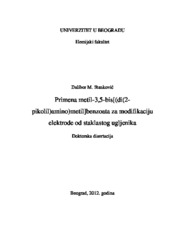Prikaz osnovnih podataka o disertaciji
Primena metil-3,5-bis[(di(2-pikoli)amino)metil]benzoata za modifikaciju elektrode od staklastog ugljenika
Application of methyl-3,5-bis[(di(2-pikolil)amino)methyl]benzoate for modification of glassy carbon electrode
| dc.contributor.advisor | Manojlović, Dragan | |
| dc.contributor.other | Roglić, Goran | |
| dc.contributor.other | Vukićević, Rastko | |
| dc.creator | Stanković, Dalibor | |
| dc.date.accessioned | 2016-01-05T12:59:47Z | |
| dc.date.available | 2016-01-05T12:59:47Z | |
| dc.date.available | 2020-07-03T10:13:00Z | |
| dc.date.issued | 2012-06-08 | |
| dc.identifier.uri | http://eteze.bg.ac.rs/application/showtheses?thesesId=547 | |
| dc.identifier.uri | https://nardus.mpn.gov.rs/handle/123456789/3470 | |
| dc.identifier.uri | https://fedorabg.bg.ac.rs/fedora/get/o:6659/bdef:Content/download | |
| dc.identifier.uri | http://vbs.rs/scripts/cobiss?command=DISPLAY&base=70036&RID=43525135 | |
| dc.description.abstract | Cilj ove doktorske disertacije jeste razvoj novog tipa modifikovane elektrode na bazi staklastog ugljenika i njene optimizacije za odredjivanje sadržaja mikroelemenata u uzorcima iz životne sredine. Ova elektroda bi se bez prethodne pripreme koristila za određivanja sadržaja mikroelemenata u vodi, kao i u biološkim uzorcima i uzorcima zemljišta nakon mikrotalasne digestije.Razvoj ovakve elektrode unapredio bi današnje elektroanalitičke tehnike koje se zasnivaju na određivanju sadržaja mikroelemenata na visećoj kapi žive kao radnoj elektrodi, kao i na elektrodi od tankog živinog filma, iako ove imaju veoma nisku granicu detekcije i odličnu reproduktivnost. Zbog toksičnosti žive i njenih soli, elektrode od nje sve manje se koristi kao radne elektrode, a u nekim zemljama upotreba žive je potpuno zabranjena. Zbog toga se danas razvija veliki broj različitih tipova modifikovanih elektroda koje bi u budućnosti mogle da zamene živine electrode, a koje bi imale iste ili bolje karakteristike od ovih, što se pre svega odnosi na granicu detekcije, osetljivost i postizanje veće selektivnosti (zbog specifičnosti modifikovanih electroda). Najčešći primer modifikovanih elektroda predstavljaju elektrode modifikovane organskim jedinjenjima, koja mogu biti specifične i selektivne jonofore, ugrađene u polimernu matricu. Takve jonofore se mogu koristiti kao senzitivni elementi na radnim elektrodama prilikom elektroanalitičkih merenja. Na ovom principu razvijen je novi tip elektrode gde je kao polimerna matrica korišćen nafion a kao selektivna jonofora za modifikaciju kompleks metil-3,5-bis[(di(2- pikolil)amino)metil]benzoata sa bakrom (Cu-DPABA) na elektrodi od staklastog uglejnika (Cu-DPABA–NA/GCE). U cilju postizanja optimalnih rezultata, prvenstveno u pogledu granice detekcije i selektivnosti, ispitani su sledeći parametri: – debljina filma, – potencijal depozicije, – vreme depozicije i – pH opseg, elektrolit i stabilnost elektrode. | sr |
| dc.description.abstract | The aim of this dissertation is the development of a new type of modified electrode based on glassy carbon, and its optimization for the determination of trace elements in environmental samples. This electrode would be used without prior preparation for the determination of trace elements in water, and in biological and soil samples prepared with microwave digestion. The development of such electrode would improve the present electroanalytical technique, which are based on the determination of trace elements on the hanging mercury drop as working electrode, and thin film of mercury electrode, although these electrodes have very low detection limit and excellent reproducibility. Because of the toxicity of mercury and its salts, mercury electrodes are less and less is use as working electrodes, and in some countries the use of mercury is completely forbidden. Now is a number of different types of modified electrodes in develop, that may eventually replace mercury electrode, and have the same or better performance, primarily related to the detection limit, sensitivity and greater selectivity (due to the specificificity of modified electrode). The most common example of modified electrodes are electrodes modified with organic compounds, which can be specific and selective ionophore, embedded in the polymer matrix. Such ionophores can be used as sensitive elements of the working electrodes in electroanalytical measurements. Based on this, a new type of electrode was developed. Nafion was used as polymer matrix, and as a selective ionophore for modification a complex methyl-3 ,5- bis [(di (2-pikolil) amino) methyl] benzoate with copper (Cu-DPABA) on a glassy carbon electrode was used (Cu-DPABA-NA/GCE). In order to achieve optimal results, especially in terms of detection limits and selectivity, following parameters were investigated: - Thickness of the film, - The potential of deposition, - Time of deposition, and - pH range, the electrolyte and electrode stability. | en |
| dc.format | application/pdf | |
| dc.language | sr | |
| dc.publisher | Универзитет у Београду, Хемијски факултет | sr |
| dc.relation | info:eu-repo/grantAgreement/MESTD/Basic Research (BR or ON)/172030/RS// | |
| dc.rights | openAccess | en |
| dc.rights.uri | https://creativecommons.org/licenses/by-nc-nd/4.0/ | |
| dc.source | Универзитет у Београду | sr |
| dc.subject | modifikovane elektrode | sr |
| dc.subject | modified electrodes | en |
| dc.subject | jonofora | sr |
| dc.subject | nafion | sr |
| dc.subject | ciklična voltametrija | sr |
| dc.subject | metode sa obogaćivanjem i sukcesivnim rastvaranjem | sr |
| dc.subject | bakar | sr |
| dc.subject | olovo | sr |
| dc.subject | kadmijum | sr |
| dc.subject | ionophore | en |
| dc.subject | Nafion | en |
| dc.subject | cyclic voltammetry | en |
| dc.subject | methods of enrichment and successive dissolution | en |
| dc.subject | copper | en |
| dc.subject | lead | en |
| dc.subject | cadmium | en |
| dc.title | Primena metil-3,5-bis[(di(2-pikoli)amino)metil]benzoata za modifikaciju elektrode od staklastog ugljenika | sr |
| dc.title | Application of methyl-3,5-bis[(di(2-pikolil)amino)methyl]benzoate for modification of glassy carbon electrode | en |
| dc.type | doctoralThesis | en |
| dc.rights.license | BY-NC-ND | |
| dcterms.abstract | Манојловић, Драган; Вукићевић, Растко; Роглић, Горан; Станковић, Далибор; Примена метил-3,5-бис[(ди(2-пиколи)амино)метил]бензоата за модификацију електроде од стакластог угљеника; Примена метил-3,5-бис[(ди(2-пиколи)амино)метил]бензоата за модификацију електроде од стакластог угљеника; | |
| dc.identifier.fulltext | https://nardus.mpn.gov.rs/bitstream/id/29368/Disertacija.pdf | |
| dc.identifier.fulltext | http://nardus.mpn.gov.rs/bitstream/id/29368/Disertacija.pdf | |
| dc.identifier.doi | 10.2298/bg20120608stankovic | |
| dc.identifier.rcub | https://hdl.handle.net/21.15107/rcub_nardus_3470 |


